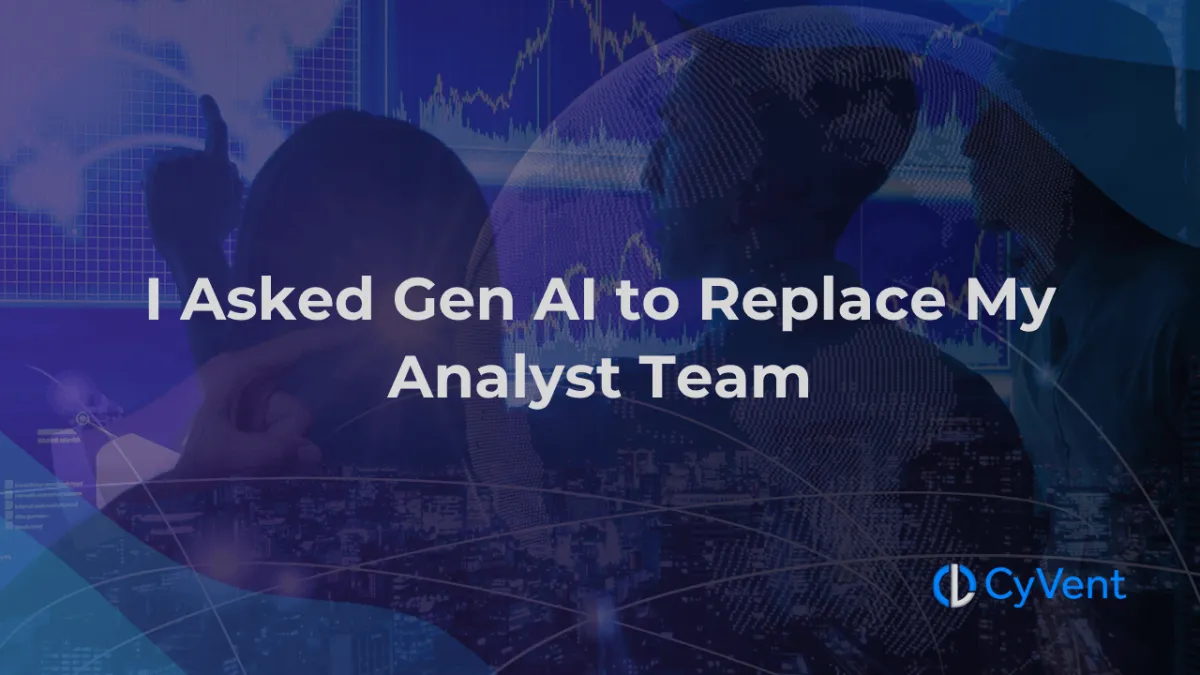
I Asked Gen AI to Replace My Analyst Team: Here’s What Happened…
By Yuda Saydun, President of CyVent
Could GenAI Really Replace My Security Analysts?

Late one night, our team was once again stretched thin, drowning in alerts, jumping between consoles, and manually reviewing logs. It was a familiar scene: too many incidents, too little time.
That’s when I asked myself:
What if I replaced my analyst team with GenAI?
Not entirely, of course. But could generative AI tools handle triage, summaries, and initial remediations? Could they really take on critical security operations tasks?
We ran an experiment to find out.
Why Test Generative AI in Security?

Security leaders are facing the squeeze:
Analyst burnout
Alert fatigue
Budget constraints
Talent shortages
Meanwhile, generative AI applications are everywhere. From text generation and code writing to content creation and image generation, these tools are reshaping how businesses operate.
And in cybersecurity? The promises of generative AI are even more appealing:
24/7 triage
Faster response
Reduced overhead
But hype is cheap. We wanted to test the real-world capabilities - and limits - of modern generative AI systems inside a functioning SOC.
How Generative AI Models Work

Most generative AI models - like ChatGPT or Claude - are trained using machine learning models built on massive training data sets. These include log data, documentation, human feedback, and annotated threats.
The training process helps these AI models recognize patterns and relationships in complex systems. Some of the most advanced are foundation models and large language models that rely on natural language processing and advanced architectures like neural networks.
The result? They can generate reports, recommend actions, and even simulate how an analyst might think - at least on paper.
Inside Our Experiment

We used multiple AI tools, including security copilots and general-purpose language models.
We fed them real but anonymized alert data and asked each model to:
Triage incidents
Recommend next steps
Summarize what happened
Identify potential root causes
We also provided supporting docs and some background context, though the data was unlabeled.
Our goal? Test how generative artificial intelligence performs on actual SOC tasks, without human guidance.
What GenAI Got Right

✅ Fast Triage
GenAI processed logs in seconds, surfacing obvious IOCs quickly. Compared to junior analysts, the speed was impressive.
✅ Clean Summaries
Using text generation, GenAI produced readable incident summaries from fragmented logs - something even experienced humans struggle with.
✅ Playbook Drafting
It could draft initial SOPs and suggest next steps by pulling from internal knowledge bases and training data.
These were clear examples of generative AI’s ability to enhance security workflows.
Where It Fell Short

❌ No Business Context
It lacked understanding of risk appetite, asset value, or business-specific policies.
❌ Hallucinations
Sometimes, it offered remediations that didn’t make sense or misunderstood alert logic entirely.
❌ Weak Correlation
Without clear prompting, GenAI failed to connect related events across systems. Even many generative AI models we tested had this flaw.
❌ Prioritization Gaps
It couldn’t tell the difference between a low-risk config error and a major security breach.
Bottom line: without business logic and context, GenAI can’t fully replace human judgment.
Key Learnings on AI-Generated Content

GenAI is a productivity tool, not a standalone analyst
It needs guardrails, context, and human review
You must monitor for hallucinations and false positives
Use generative AI techniques to support - not replace - analysts
We also saw how generative models are only as good as the training data they’re built on. Poor or biased data = poor results.
Where GenAI Shines in Cybersecurity

When used strategically, generative AI solutions can:
Accelerate low-value, high-volume tasks
Auto-generate alert summaries
Draft reports and SOPs
Help train new team members
Support AI-generated content for internal tooling
This aligns with the broader shift toward augmented intelligence - humans + AI agents, not AI vs. humans.
Final Thoughts

Generative AI technology is evolving fast. But we’re not yet at the point where it can safely replace analyst teams.
Still, the potential of generative AI in security operations is real - if it’s implemented responsibly. With the right oversight, it can reduce burnout, increase velocity, and free up your best people for higher-level work.
In short: don’t replace your team. Augment them.
P.S. Wondering where GenAI fits in your stack - or what tools are worth testing? Book a free consultation with CyVent. We’ll help you identify real opportunities, build a roadmap, and avoid the most common pitfalls.


